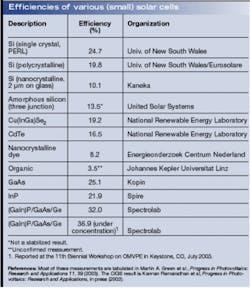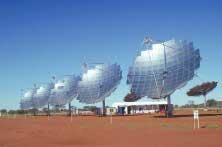Solar electricity: Pie in the sky gets a piece of the action
The vision inspired by the oil embargo of the 1970s was clear. The United States would wean itself from its dependence on foreign oil by developing renewable energy resources such as solar electricity. And why not? Every hour, enough sunlight strikes Earth to supply the world with energy for a year. If we covered all our roads—or an equivalent space—with solar cells, they would generate enough electricity to meet our nation's needs.
By the late 1980s and into the 1990s, however, the hope that solar energy would become a healthy slice of the national energy portfolio began to look like pie in the sky. The renewable energy vision of the 1970s did not, and has not, come to pass, mostly because the cost of fossil fuels did not continue to rise. In real dollars, oil and natural gas cost about the same now as they did 20 years ago. But there is a bright side: the costs of renewable energy technologies have declined steadily, allowing new markets to be addressed.
New uses for solar
In the 1980s, companies found that replacing the battery and on/off switch in calculators with a small solar cell resulted in a better product at a lower cost. Not only was the solar cell the cheaper option, but the solar-powered calculator could be made thin enough to fit in a wallet, and the batteries never needed to be replaced. Since that time, solar-powered products have become commonplace, providing power for roadside flashing lights, roadside emergency phones, remote telecommunications stations, walk lights, and other low-wattage systems.
These days, even some large solar-powered systems are cost competitive. For example, solar panels may provide the lowest-cost way to power a remote home.1 The fastest growing segment of the market today is building-integrated applications. Solar cells can be integrated into the facade of a building in aesthetically pleasing ways (see Fig. 1).
Of course, electricity is often needed when the sun isn't shining. For stand-alone solar-powered systems, this requires the addition of batteries, which increases system cost and maintenance. But when solar cells are used to meet peak demand, no battery backup is required. In the United States, peak electricity consumption occurs during the summer when air-conditioning loads are high. We build power plants to meet peak demand during the hot hours of the day, and then allow these plants to sit idle at night when demand is lower. The hottest days of summer are usually the days when the sun is shining strongly and solar cells are at their maximum output. Thus, using solar cells to generate a certain percentage of our electricity—10% may be practical—can help meet our peak demand without need for nighttime storage. Many believe that, eventually, hydrogen could be generated from sunlight during the day, and then used to generate electricity in fuel cells at night, achieving the vision of the 1970s.
The workings of a solar cell
The structure of most solar cells is a simple p-n diode. An antireflection coating on the front of the diode increases the amount of sunlight available for conversion to electricity. The cell absorbs sunlight, creating free electrons and holes that are then separated by the p-n junction and carried by wires to the external circuit. This structure is closely related to diodes used for light-emitting diodes—essentially, solar cells run in reverse.
The discovery that gallium nitride and related materials make good LEDs has revolutionized that industry. Research on new materials for solar cells has been motivated by the hope that a similar revolution could dramatically change the solar cell industry by identifying a cheaper product. The thin-film solar cell is one candidate, because it requires very little semiconductor material (layers about 1 to 10 µm thick) and can be made on a cheap substrate such as glass.
A range of semiconductor materials and alloys are being used for solar cells (see table ). The highest efficiency cells are made from single-crystal, III-V materials such as gallium arsenide. Multijunction stacks of these materials have efficiencies exceeding 30%, and are currently used to power satellites.
An expanding market
Crystalline silicon technologies dominate the solar-electric world, controlling about 90% of the market. With manufacturing costs still dropping and efficiencies still rising, no end to this domination is in sight. Nevertheless, other technologies could still stake claims. Their entrée into a respectable market share will likely be based on low material and/or manufacturing costs or high efficiency. For example, thin copper indium selenide (CuInSe2) cells made on glass have achieved efficiencies approaching 20% and are commercially available.2 Just as many different types of batteries are used for different applications, several solar-cell technologies will likely be "winners." Amorphous silicon is currently the technology of choice for any application that requires a very thin, flexible module. The largest solar-cell markets today require building integration, and so far, silicon solar cells (in single-crystal, polycrystalline, or amorphous forms) have proven to be the best choice.
The ultimate market for solar cells—electric utilities—has thus far been elusive because electricity from solar is more expensive than that generated by fossil fuels. However, in response to popular demand for "green" electricity, utilities such as Arizona Public Service (APS) and Tucson Electric Power are installing large fields of solar electric systems (see Fig. 2). In this type of application, concentrator systems may turn out to be the technology of choice. Concentrator systems use lenses or mirrors to focus light onto very small solar cells. Because the area of the cell can be made very small, a higher-efficiency, more expensive solar cell can be used. The Amonix (Torrance, CA) concentrator systems that APS is installing use silicon concentrator cells that are about 25% efficient. Efforts are under way to replace these with multijunction III-V solar cells, which have already demonstrated over 35% efficiency and may someday reach 40%.3 Concentrator systems are not yet manufactured in the volume needed to reduce their cost below that of silicon flat-plate systems, so the APS/Amonix team is currently the only one in the United States taking advantage of this technology. Solar Systems (Melbourne, Australia) is installing dish concentrator systems in Australia (see Fig. 3).
Closing the gap
Other related technologies are developing apace, opening up new marriages and new markets for solar cells. Efficient LEDs reduce the amount of power needed to run a flashing light, thus serving as an enabling technology for new solar-powered applications. When power demand is reduced, solar energy becomes more attractive, because just a small amount (that is, a smaller system) can get the job done. Another interesting combination would pair fuel cells with solar cells. If fuel cells can be manufactured inexpensively, fuel cell/solar cell systems could one day provide round-the-clock power.
So where do we stand? With each passing year, solar electricity commands a larger piece of the power-generation action. If sales of solar cells continue to grow at the current rate—about 33% annually over the last five years—solar electricity will begin to dominate the energy mix for new electricity-generating installations in less than 20 years. Ultimately, such a trend could greatly reduce reliance on imported fossil fuels and reduce the associated pollution and greenhouse gas emissions.
Pie in the sky no longer, today's solar electricity offers considerable sustenance. For a nation and a world hungry for clean energy, it's about time.
REFERENCES
- Solar-power systems with battery or diesel backup typically cost in the range of $10,000 to $30,000, whereas running a power line one mile may cost between about $10,000 and $50,000, depending on the terrain and cost of labor.
- See www.oksolar.com/PV/Siemens.html
- R. R. King et al., "High-Efficiency Space and Terrestrial Multijunction Solar Cells Through Bandgap Control in Cell Structures," presented at the 29th IEEE Photovoltaic Specialists Conf., New Orleans, LA, (May 19–24, 2002).
SARAH KURTZ is a principal scientist and SUSAN MOON is a senior writer at the National Renewable Energy Laboratory, 1617 Cole Blvd., Golden, CO 80401; e-mail: [email protected].




